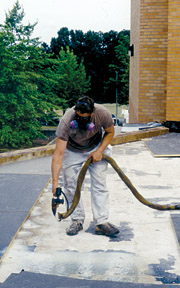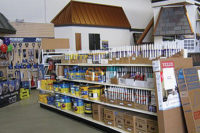
Polyurethane insulating adhesive, also known as low-rise foam or foam adhesive, has seen a marked increase in use in recent years. More and more roofing specifications are calling for the fully adhered PIA approach over mechanical fasteners. Contractors who can install a quality roof system using low-rise foam are finding they have a distinct business advantage.
“Using the low-rise foam limits our competition,” says Andy Sheridan, estimator and project manager for Apple Roofing of Syracuse, N.Y. “There are not a lot of contractors installing this product in this area, so that provides us with a better opportunity to bid and get the job. It gives us more artillery for our arsenal when we go into a situation where it’s needed or required. There are a lot of advantages.”
Apple Roofing installs all standard commercial roofing systems: built-up roofing, PVC, EPDM, modified bitumen, shingle, slates and standing-seam metal roofs. Sheridan says his company uses PIA with most of the single-ply systems, usually with PVC and EPDM.
“I’ve never installed a built-up roof using the low-rise foam,” he says. “But you could for the insulation attachment. You could use PIA with pretty much any system in the proper conditions and if code approvals are met for the specified manufacturer.”
Like its “big brother” spray polyurethane foam, PIA is spray applied to the substrate. Also like SPF, it is manufactured on site, but engineered on the molecular level to perform a specific task. BASF Corp., Wyandotte, Mich., reports that its water-blown, low-viscosity PIA product, available in formulations for both hot and cold environments, sets in five to 10 minutes and has passed FM Global wind uplift tests with several substrates.
Another performance advantage offered by polyurethane foam adhesive is the elimination of thermal bridging. Whereas mechanical fasteners often add to this problem, the seamless, monolithic application of polyurethane foam adhesive actually helps provide more insulation for the roof system, as well as helping to fill in the spaces between the insulation boards.
For most applications, the PIA is sprayed to the deck and the insulation board stock is placed in the foam adhesive before it rises and sets. The board stock can then be sprayed with another pass of PIA and the membrane system laid overtop.
“It’s a good choice for any building where the fasteners might be a problem such as school gyms — I have seen a lot of tennis and kick balls stuck to the fasteners on the bottom side of the deck — or where aesthetics are an issue and fasteners may be visible from the interior,” says Sheridan.
PIA really comes into its element when the contractor is faced with a non-nailable deck or where mechanical fasteners would be difficult to apply, such as concrete, tectum or gypsum. “That’s when I really like to see the low-rise foam. The cost of the material is greater, but its installation with a qualified crew is much easier, with no hammer drilling or pre-drilling of the deck.”
Sheridan says PIA has helped Apple Roofing to get the job done, even when unexpected problems arise on the job site. “Low-rise foam allows for increased flexibility for problem solving in the field with re-roofing, especially when partway through a job you encounter different deck types that are not suitable for the specified fasteners — where you won’t get the proper pullout value,” he says. “Before, we were limited to hot asphalt attachment of the insulation and that means bringing in asphalt in a kettle, propane, equipment and depending on the building elevation, you might have difficulty getting the asphalt to the roof level where you need to apply it. With this system, you just locate the machine and the barrels right on the roof and you can cover quite a bit of work area before you have to relocate the machine again. It allows us to problem-solve without destroying the work schedule.”
He says Apple Roofing has been using low-rise foam since 2000, when it first solved an on-site problem on a project in Rochester, N.Y. “The first project Apple Roofing installed using PIA originally specified white fasteners, but it was discovered after the fasteners were installed that they became discolored which was not aesthetically acceptable to the owner. After review of several different applications to resolve this issue it was decided to use the PIA for this project. The spray foam manufacturer’s technical staff, as well as the rep for the product, came to the job site and instructed us and gave us training on-site so we didn’t have to hire any new staff to apply the foam adhesive,” he says. “Every new system has a learning curve to it, but we’re getting a lot better and a lot faster with the foam adhesive now.”
In the right application, it can save the customer money too. “If you have a concrete deck with a lot of rebar and a complex tapered insulation system, the savings on the SDS drill bits themselves can save a lot of money,” he says.

A Case in Point: The Cayuga County Office Building
Dave Gelsi is a senior roofing designer with more than 35 years of experience. Cayuga County sought assistance from the 104-year-old architectural firm Beardsley Design Associates when they began to experience leaks and resulting interior damage in the County Office Building in Auburn, N.Y.The existing 13,384-square-foot roof with a 109-foot elevation was a 15-year-old EPDM system, mechanically fastened into the concrete deck. The building, a high-profile local landmark, housed the chambers of the county legislators. Gelsi specified low-rise foam for attaching the insulation and an adhered, heat-welded Sarnafil PVC membrane for the reroofing project.
“I decided on the low-rise foam for several reasons,” he says. “First of all, it was a concrete deck that wouldn’t withstand the hammering and pounding and drilling of mechanical fasteners. Secondly, at six stories high, it would be very hard to feed any other type of adhesive system, such as hot asphalt, to the roof. And finally, it was occupied, so we had to be fairly quiet and careful during the installation. Plus, the foam is very adhesive-minded; it sticks to anything and everything.”
Andy Sheridan and Apple Roofing had been involved in the project preliminaries, performing test cuts and providing preliminary pricing. When the bids for the work were collected from several contractors, Apple got the nod.
“They were successful on several of our other projects over the years,” says Gelsi. “This job went very smoothly without any problems. They were on schedule and they did a nice job. The roof is performing very well and we haven’t had any reports of problems at all.”
“Incorporating the low-rise foam into our roofing mix has absolutely helped our business,” says Sheridan. “It helps us bid on and win more jobs, and it helps us to get them done quickly and more efficiently.”

Report Abusive Comment